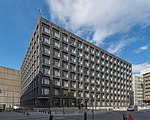Swedish National Bank
|
|||
| Headquarters | |||
|---|---|---|---|
| Established | 1668 | ||
| Governor | Stefan Ingves | ||
| Central bank of | Sweden | ||
| Currency |
Swedish krona SEK (ISO 4217) |
||
| Reserve requirements | None | ||
| Bank rate | -0.5 | ||
| Interest on reserves | -1.25 | ||
| Interest paid on excess reserves? | not applicable (no reserve requirements) | ||
| Preceded by | Riksens Ständers Bank (1866) Stockholms Banco (1668) |
||
| Website | www |
||
Sveriges Riksbank, or simply Riksbanken, is the central bank of Sweden. It is the world's oldest central bank and the 3rd oldest bank still in operation. It is sometimes called the Swedish National Bank or the Bank of Sweden (not to be confused with Swedbank, a retail bank).
The Riksbank began operations in 1668. Previously, Sweden was served by the (also known as the Bank of Palmstruch), which was founded by Johan Palmstruch in 1656. Although the bank was private, it was the king who chose its management: in a letter to Palmstruch, he gave permission to its operations according to stated regulations. But Stockholms Banco collapsed as a result of the issuing of too many notes without the necessary collateral. Palmstruch, who was considered responsible for the bank's losses, was condemned to death, but later received clemency. On 17 September 1668, the privilege of Palmstruch to operate a bank was transferred to the Riksens Ständers Bank ("Bank of the Estates of the Realm") and was run under the auspices of the parliament of the day. Due to the failure of Stockholm Banco, the new bank was managed under the direct control of the Riksdag of the Estates to prevent the interference from the king. When a new Riksdag was instituted in 1866, the name of the bank was changed to Sveriges Riksbank.
Having learnt the lesson of the Stockholms Banco experience, the Riksbank was not permitted to issue bank-notes. Nevertheless, in 1701, permission was granted to issue so called credit-notes". Some time in the middle of the 18th century, counterfeit notes began appearing, which caused serious problems. To prevent forgeries, it was decided that the Riksbank should produce its own paper for bank-notes and a paper-mill, Tumba Bruk, was founded in Tumba, on the outskirts of Stockholm.
A few years later, the first commercial banks were founded and these were also allowed to issue bank-notes. The bank-notes represented a claim to the bank without interest paid, and thus became a considerable source of income for banks. Nonetheless, security in the form of a deposit at the Riksbank was required to cover the value of all notes issued.
...
Wikipedia


